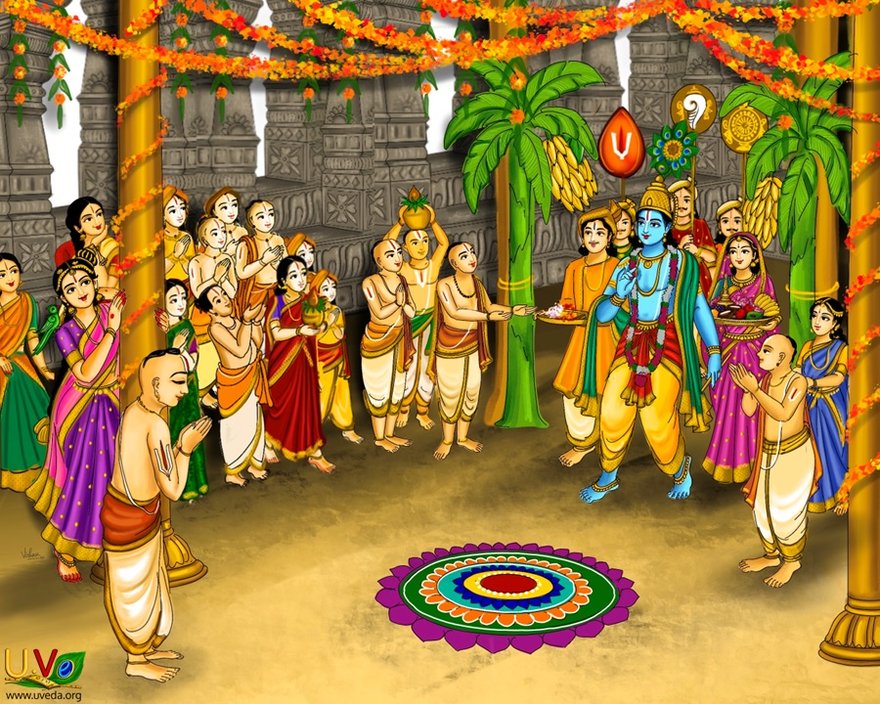NAT 6.2
I Dreamt that the Bull-like Govinda Was Coming
கோவிந்தனாகிய காளைவரக் கனாக்கண்டேன்

557 நாளைவதுவை மணமென்றுநாளிட்டு *
பாளைகமுகு பரிசுடைப்பந்தற்கீழ் *
கோளரிமாதவன் கோவிந்தனென்பான் ஓர் *
காளைபுகுதக் கனாக்கண்டேன் தோழீ! நான்.
பாளைகமுகு பரிசுடைப்பந்தற்கீழ் *
கோளரிமாதவன் கோவிந்தனென்பான் ஓர் *
காளைபுகுதக் கனாக்கண்டேன் தோழீ! நான்.
NAT.6.2
557 nāl̤ai vatuvai- * maṇam ĕṉṟu nāl̤ iṭṭu *
pāl̤aik kamuku * paricu uṭaip pantal kīzh **
kol̤ari mātavaṉ * kovintaṉ ĕṉpāṉ or *
kāl̤ai pukutak * kaṉāk kaṇṭeṉ tozhī ! nāṉ (2)
pāl̤aik kamuku * paricu uṭaip pantal kīzh **
kol̤ari mātavaṉ * kovintaṉ ĕṉpāṉ or *
kāl̤ai pukutak * kaṉāk kaṇṭeṉ tozhī ! nāṉ (2)
Ragam
Kalyāṇi / கல்யாணி
Thalam
Jambai / ஜம்பை
Bhavam
Nāyaki (lovelorn lady)
Simple Translation
557. O friend, I had a dream.
My relatives decide the day for my wedding.
They decorate a beautiful pandal with kamugu trees.
Mādhavan Govindan who once took a form of a lion,
strong as a bull, enters into the pandal—
I saw Him in my dream.
Word by Word (WBW) meaning
(The words may be rearranged to facilitate conversion from poetry to prose (Aṉvayam). Please read the meanings (in black) continuously to form the sentence and understand the simplified meaning based on the Divyārtha Dīpikai for the verse.)
தோழீ! — தோழியே!; நாளை — நாளைக்கு; வதுவை மணம் என்று — திருமணம் என்று; நாள் இட்டு — நாள் பார்த்து; பாளை — பாளைகள் உள்ள; கமுகு — பாக்கு மரங்களால் ஆன; பரிசுடை — அலங்கார; பந்தல் கீழ் — பந்தலின் கீழே; கோளரி — நரசிம்மனென்றும்; மாதவன் — மாதவனென்றும்; கோவிந்தன் — கோவிந்தனென்றும்; என்பான் ஓர் — நாமமுடைய ஒரு; காளை புகுத — காளைப் புகுவதை; நான் — நான்; கனாக் கண்டேன் — கனவில் கண்டேன்
toḻī! — oh friend!; nāl̤ai — tin that tomorrow; nāl̤ iṭṭu — an auspocious day was chosen; vatuvai maṇam ĕṉṟu — for the wedding; pantal kīḻ — under the ceremonial canopy (pandal); paricuṭai — that was decorative; kamuku — made of betel trees; pāl̤ai — and banana leaves; nāṉ — I; kaṉāk kaṇṭeṉ — saw in the dream; ĕṉpāṉ or — that my Lord; kāl̤ai pukuta — who is like a strong Bull enters; kol̤ari — who is called Narasimhan; mātavaṉ — Madhavan; kovintaṉ — and Govindhan
Detailed Explanation
Avatārikai (Introduction)
In this sublime pāsuram, the divine Āṇḍāzh confides in her dear friend (tōzhi), revealing to her a most sacred and wondrous vision. She declares, "In my dream, I witnessed the glorious Kaṇṇan Himself, my Lord and Master, making His grand entrance into the sacred wedding hall (maṇappandhal)."
Simple Translation
O my dear